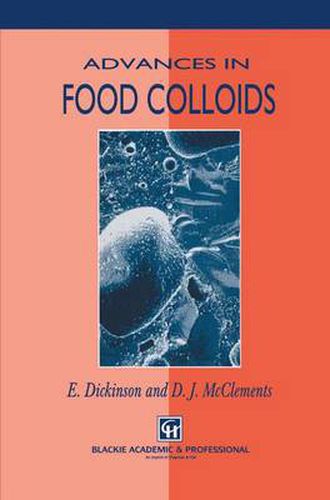Readings Newsletter
Become a Readings Member to make your shopping experience even easier.
Sign in or sign up for free!
You’re not far away from qualifying for FREE standard shipping within Australia
You’ve qualified for FREE standard shipping within Australia
The cart is loading…






This title is printed to order. This book may have been self-published. If so, we cannot guarantee the quality of the content. In the main most books will have gone through the editing process however some may not. We therefore suggest that you be aware of this before ordering this book. If in doubt check either the author or publisher’s details as we are unable to accept any returns unless they are faulty. Please contact us if you have any questions.
The field of food colloids is concerned with the physical chemistry of food systems viewed as assemblies of particles and macromolecules in various states of supramolecular and microscopic organization. The objective is to relate the equilibrium and dynamic properties of the system to the inter actions amongst the constituent molecular and particulate entities. The emphasis is on structure and kinetics at the colloidal scale, and with the distribution of molecular food components (proteins, lipids, poly saccharides, etc.) between dispersed and continuous bulk phases (water, fat, air, etc.) and various kinds of interfaces (oil-water, air-water, etc.). Food products such as butter, cheese, ice-cream, margarine, mayonnaise of food colloids. and yoghurt are all examples This book describes some recent experimental and theoretical develop ments in the field of food colloids. By way of background, we start with a brief survey of the current consumer trends which may point the way towards future research opportunities in the field. Chapter 1 also attempts to illustrate the way in which advances in instrumental methods and experimental investigations of well-defined mixed protein-surfactant systems are offering new insights into the structure of protein adsorbed layers and the competitive adsorption of proteins in oil-in-water emulsion systems.
$9.00 standard shipping within Australia
FREE standard shipping within Australia for orders over $100.00
Express & International shipping calculated at checkout
This title is printed to order. This book may have been self-published. If so, we cannot guarantee the quality of the content. In the main most books will have gone through the editing process however some may not. We therefore suggest that you be aware of this before ordering this book. If in doubt check either the author or publisher’s details as we are unable to accept any returns unless they are faulty. Please contact us if you have any questions.
The field of food colloids is concerned with the physical chemistry of food systems viewed as assemblies of particles and macromolecules in various states of supramolecular and microscopic organization. The objective is to relate the equilibrium and dynamic properties of the system to the inter actions amongst the constituent molecular and particulate entities. The emphasis is on structure and kinetics at the colloidal scale, and with the distribution of molecular food components (proteins, lipids, poly saccharides, etc.) between dispersed and continuous bulk phases (water, fat, air, etc.) and various kinds of interfaces (oil-water, air-water, etc.). Food products such as butter, cheese, ice-cream, margarine, mayonnaise of food colloids. and yoghurt are all examples This book describes some recent experimental and theoretical develop ments in the field of food colloids. By way of background, we start with a brief survey of the current consumer trends which may point the way towards future research opportunities in the field. Chapter 1 also attempts to illustrate the way in which advances in instrumental methods and experimental investigations of well-defined mixed protein-surfactant systems are offering new insights into the structure of protein adsorbed layers and the competitive adsorption of proteins in oil-in-water emulsion systems.